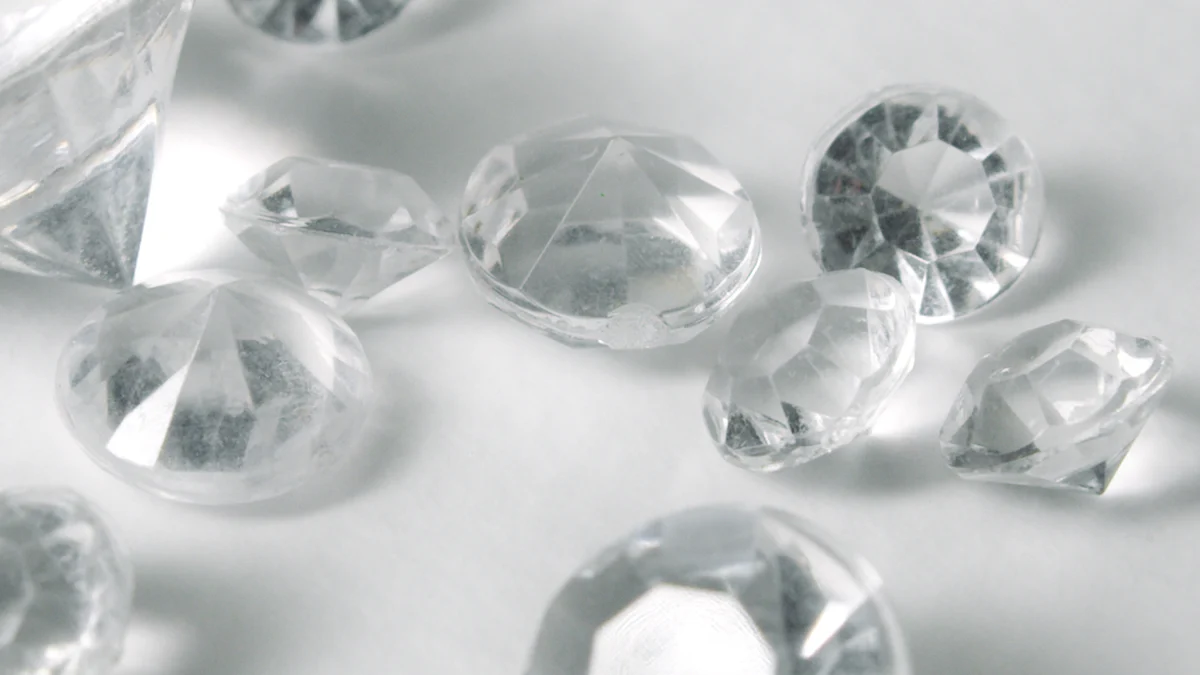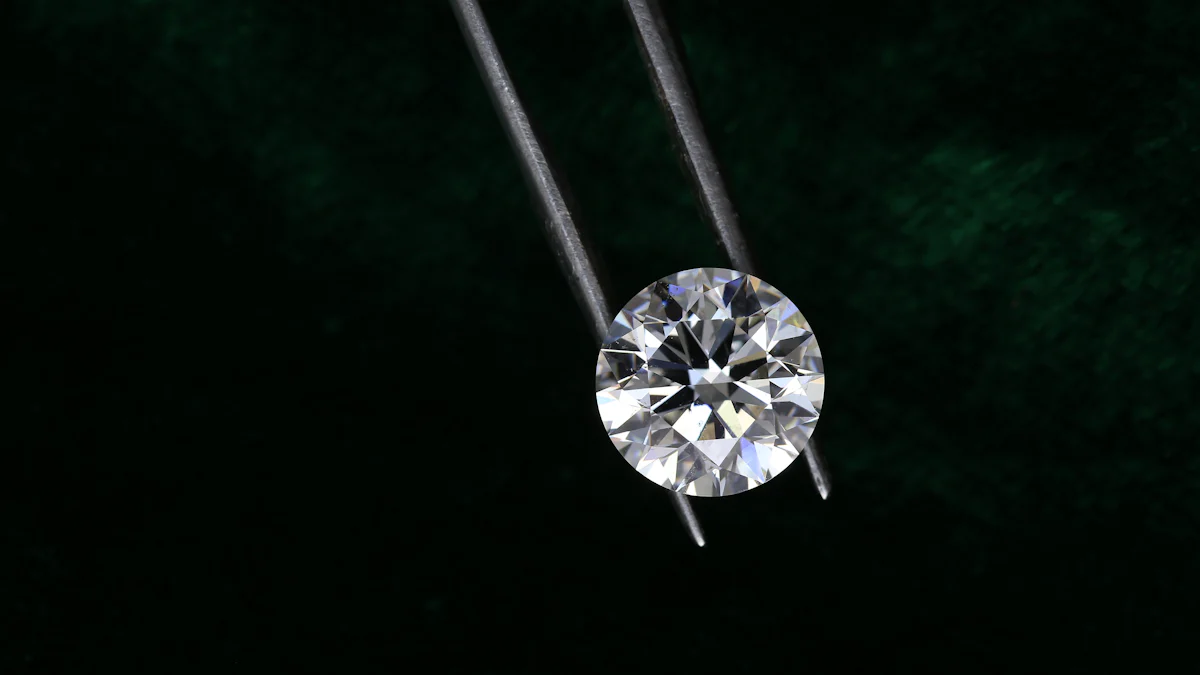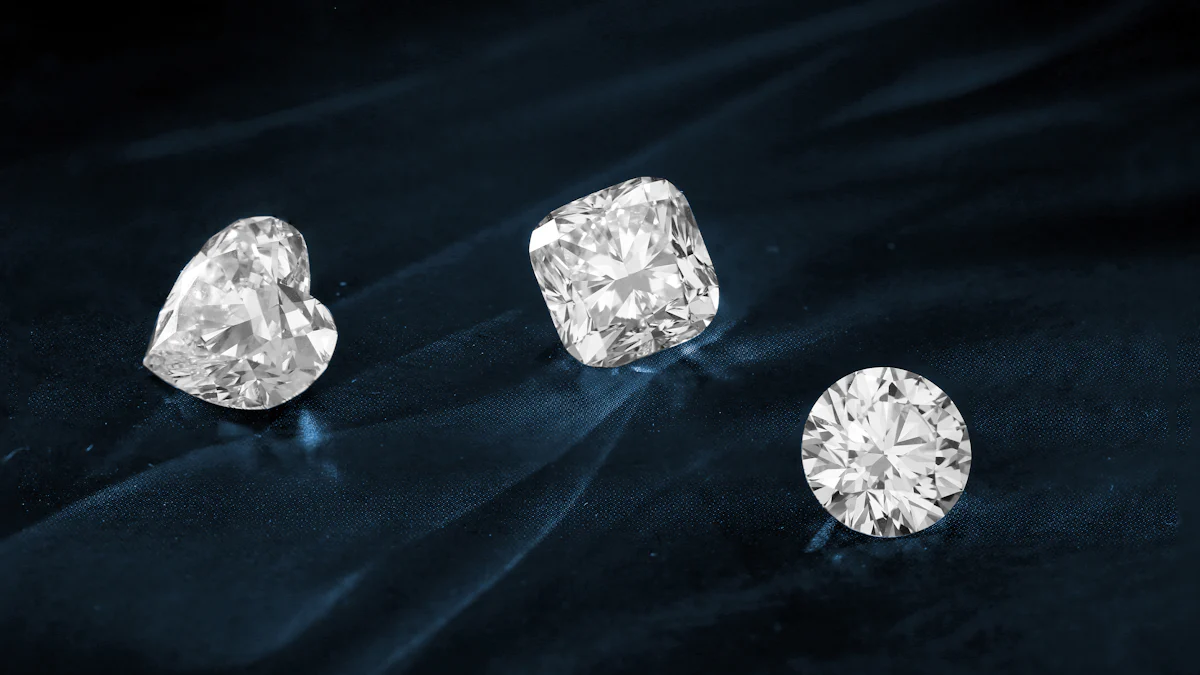Comparing I1 Diamonds with SI and VS Clarity Grades

When selecting a diamond, clarity plays a crucial role in its beauty and value. An i1 diamond offers a budget-friendly option, but its visible inclusions often reduce brilliance and durability. These inclusions can significantly impact how light interacts with the stone, diminishing its sparkle. In contrast, SI and VS clarity grades provide fewer inclusions, enhancing the diamond's visual appeal. If you prioritize quality, VS diamonds typically appear eye-clean, while SI diamonds balance affordability and aesthetics. Understanding these differences helps you choose a clarity grade that aligns with your budget and preferences.
Understanding Diamond Clarity Grades and Their Importance

What Are Diamond Clarity Grades?
Diamond clarity grades measure the presence of imperfections, known as inclusions and blemishes, within a diamond. These grades help you understand how these flaws affect the diamond's appearance and value. The Gemological Institute of America (GIA) developed the widely recognized diamond clarity chart, which categorizes diamonds into six main clarity grades: Flawless (FL), Internally Flawless (IF), Very Slightly Included (VS1 and VS2), Slightly Included (SI1 and SI2), and Included (I1, I2, and I3). Each grade reflects the size, number, and visibility of inclusions under 10x magnification.
Clarity grading focuses on how visible these imperfections are to the naked eye and under magnification. For example, I1 diamonds have inclusions that are easily noticeable without magnification, while VS diamonds often appear flawless to the unaided eye. If you want a diamond with fewer visible flaws, higher clarity grades like VS or SI may suit your needs better. However, understanding these grades ensures you can make an informed decision based on your budget and preferences.
Why Clarity Matters in a Diamond's Appearance and Value
Clarity plays a significant role in determining a diamond's beauty and durability. Inclusions can disrupt how light passes through the diamond, reducing its brilliance and fire. If a diamond has large or numerous inclusions, it may appear dull and less vibrant. For instance, I1 diamonds often lack the sparkle seen in higher clarity grades because their inclusions block light from reflecting effectively.
Durability is another critical factor. Inclusions, especially large ones, can weaken the diamond's structure, making it more prone to chipping or cracking. This is why clarity grading is essential when evaluating a diamond's long-term wearability. If you plan to wear the diamond daily, choosing a clarity grade with fewer inclusions, such as SI or VS, can ensure better durability.
According to studies, inclusions in diamonds not only affect their appearance but also their structural integrity. Larger inclusions can significantly impact a diamond's brilliance and fire, making them less desirable for buyers seeking high-quality stones.
Clarity also influences a diamond's value. Higher clarity grades, such as VS1 or VS2, command higher prices due to their rarity and superior visual appeal. If you are working within a budget, SI diamonds offer a balance between affordability and aesthetics. These diamonds often appear eye-clean, meaning their inclusions are not visible to the naked eye, making them a popular choice for many buyers.
Understanding diamond clarity grades helps you evaluate how inclusions affect a diamond's beauty, durability, and value. If you prioritize brilliance and longevity, selecting a diamond with a higher clarity grade can be a worthwhile investment.
Detailed Comparison of I1, SI, and VS Clarity Grades

Characteristics of I1 Diamonds
An i1 diamond sits on the lower end of the clarity scale, with inclusions that are easily visible to the naked eye. These inclusions often affect the diamond's brilliance and transparency, reducing its overall sparkle. Most i1 diamonds are not eye-clean, meaning their flaws are noticeable without magnification. However, with careful searching, you may find an i1 diamond that appears cleaner than others.
The inclusions in i1 diamonds can also impact their durability. Large or numerous flaws may weaken the stone's structure, making it more prone to damage over time. Despite these drawbacks, i1 diamonds remain a budget-friendly option for buyers who prioritize price over clarity. If you are willing to compromise on visual perfection, an i1 diamond can still serve as an affordable choice for jewelry.
Characteristics of SI Clarity Grades (SI1 and SI2)
SI diamonds, which include SI1 and SI2 grades, offer a step up in clarity compared to i1 diamonds. While inclusions are still present, many SI diamonds appear clean to the naked eye, especially in the SI1 category. These diamonds strike a balance between affordability and visual appeal, making them a popular choice for engagement rings and other fine jewelry.
SI diamonds typically have smaller and fewer inclusions than i1 diamonds. These inclusions are often less noticeable unless viewed under magnification. If you choose an SI diamond, you can enjoy a stone that looks visually appealing without exceeding your budget. However, SI2 diamonds may sometimes have inclusions visible to the naked eye, so inspecting the stone in person is essential.
For those seeking a diamond that balances cost and quality, SI clarity grades provide an excellent middle ground. They allow you to own a diamond with decent brilliance and durability without the higher price tag of VS clarity grades.
Characteristics of VS Clarity Grades (VS1 and VS2)
VS diamonds, including VS1 and VS2 grades, represent a higher level of clarity. These diamonds have very slight inclusions that are difficult to detect, even under 10x magnification. To the naked eye, VS diamonds often appear flawless, making them a preferred choice for buyers who value quality and visual perfection.
Compared to SI diamonds, VS diamonds feature fewer and smaller inclusions. This superior clarity enhances their brilliance and fire, allowing light to pass through the stone more effectively. If you prioritize a diamond with exceptional sparkle and minimal flaws, a VS clarity grade is an ideal option.
VS diamonds also offer better durability due to their lack of significant inclusions. Their structural integrity makes them suitable for daily wear, especially in engagement rings. While VS diamonds come at a higher price point, their combination of beauty and durability makes them a worthwhile investment for those seeking a premium-quality stone.
Key Differences Between I1, SI, and VS Diamonds
When comparing diamonds, understanding the differences between I1, SI, and VS clarity grades helps you make an informed decision. Each clarity grade offers unique characteristics that affect a diamond's appearance, durability, and value.
1. Visibility of Inclusions
The most noticeable difference lies in how visible the inclusions are:
- I1 diamonds have inclusions that are easily seen without magnification. These flaws often reduce the diamond's brilliance and can make it appear less attractive to the naked eye.
- SI diamonds (SI1 and SI2) typically have smaller inclusions. Many SI1 diamonds appear eye-clean, meaning their inclusions are not visible without magnification. However, SI2 diamonds may still show some inclusions to the naked eye.
- VS diamonds (VS1 and VS2) have very slight inclusions that are difficult to detect, even under 10x magnification. To the unaided eye, these diamonds often look flawless.
"VS diamonds offer remarkable clarity without the premium price tag of higher-graded stones like VVS or Flawless."
2. Brilliance and Sparkle
Inclusions directly impact how light interacts with a diamond.
- I1 diamonds often lack the sparkle seen in higher clarity grades because their inclusions block light from reflecting effectively. This can result in a duller appearance.
- SI diamonds allow more light to pass through, enhancing their brilliance compared to I1 diamonds. SI1 diamonds, in particular, can offer a good balance of sparkle and affordability.
- VS diamonds provide superior brilliance and fire. Their minimal inclusions allow light to reflect and refract more effectively, creating a dazzling sparkle.
3. Durability
The durability of a diamond depends on the size and location of its inclusions.
- I1 diamonds may have large or numerous inclusions that weaken their structure, making them more prone to chipping or cracking.
- SI diamonds generally have fewer and smaller inclusions, which improves their durability compared to I1 diamonds. SI1 diamonds, in particular, are a safer choice for daily wear.
- VS diamonds offer the best durability among the three. Their minimal inclusions ensure a stronger structure, making them ideal for engagement rings and other frequently worn jewelry.
4. Value and Affordability
Price differences reflect the clarity grades:
- I1 diamonds are the most affordable option. If you prioritize budget over visual perfection, an I1 diamond may suit your needs.
- SI diamonds cost more than I1 diamonds but offer better clarity and visual appeal. SI1 diamonds, in particular, provide excellent value for their price.
- VS diamonds command a higher price due to their superior clarity and brilliance. While they are more expensive, they represent a worthwhile investment for those seeking premium quality.
5. Overall Appeal
- I1 diamonds work best for buyers who prioritize cost and are willing to compromise on clarity and brilliance.
- SI diamonds strike a balance between affordability and aesthetics, making them a popular choice for many buyers.
- VS diamonds cater to those who value exceptional quality and are willing to invest in a diamond with superior clarity and sparkle.
By understanding these key differences, you can choose a diamond that aligns with your preferences, budget, and intended use. Whether you opt for an I1 diamond for its affordability, an SI diamond for its balance, or a VS diamond for its brilliance, the right choice depends on what matters most to you.
Practical Advice for Choosing the Right Clarity Grade
Balancing Budget and Visual Appeal
When selecting a diamond, balancing your budget with its visual appeal is essential. The clarity grade you choose significantly impacts both factors. Higher clarity grades, such as VS1 or VS2, offer exceptional brilliance and minimal inclusions, but they come with a higher price tag. On the other hand, I1 diamonds are more affordable but often have visible flaws that may affect their sparkle and durability.
If you want a balance between cost and beauty, SI clarity grades, particularly SI1, are an excellent choice. Many SI1 diamonds appear eye clean, meaning their inclusions are not visible to the naked eye. This makes them a popular option for buyers who want a visually appealing diamond without exceeding their budget. As Whiteflash, a diamond clarity expert, explains:
"When striking a balance between how much you spend and the beauty of the diamond, choosing the right clarity grade will be a significant consideration."
By understanding how clarity grades affect a diamond's appearance and price, you can make an informed decision that aligns with your financial goals and aesthetic preferences.
Considering Diamond Size and Setting
The size and setting of your diamond also play a crucial role in determining the best clarity grade. Larger diamonds tend to reveal inclusions more easily because of their greater surface area. For example, an I1 diamond in a larger carat size may show its flaws more prominently than a smaller diamond with the same clarity grade. If you are considering a larger diamond, opting for a higher clarity grade, such as SI1 or VS2, ensures a cleaner appearance.
The setting of your diamond can also help mask inclusions. Prong or bezel settings can hide flaws by covering specific areas of the stone. If you choose an I1 or SI2 diamond, selecting a setting that conceals inclusions can enhance its overall look. For smaller diamonds or those in intricate settings, lower clarity grades may suffice since inclusions are less noticeable.
When evaluating diamond size and setting, consider how these factors interact with clarity. A strategic choice can maximize the beauty of your diamond while staying within your budget.
Tips for Evaluating Diamond Clarity in Person
Evaluating diamond clarity in person allows you to see how inclusions affect its appearance. To ensure you choose the right clarity grade, follow these tips:
-
Inspect the Diamond Under Different Lighting
View the diamond under various lighting conditions to observe its brilliance and sparkle. Inclusions may appear more noticeable in certain lighting, so this step helps you assess its true visual appeal. -
Use a Loupe or Magnification
Examine the diamond with a 10x magnification loupe to identify inclusions. While higher clarity grades like VS1 or VS2 may show minimal flaws, lower grades such as I1 will reveal more visible imperfections. -
Check for Eye Clean Appearance
Determine if the diamond looks eye clean by viewing it from different angles without magnification. Many SI1 diamonds appear flawless to the naked eye, making them a great choice for balancing clarity and cost. -
Seek Expert Guidance
Consult a trusted jeweler or gemologist to understand the clarity grade and its impact on the diamond's beauty and durability. Their expertise can help you make a confident decision.
By following these steps, you can evaluate diamond clarity effectively and choose a stone that meets your expectations for both quality and value.
When choosing a diamond, understanding clarity grades helps you make an informed decision. I1 diamonds offer affordability but often show visible inclusions that can reduce brilliance and durability. SI and VS clarity grades provide better visual appeal and structural integrity, making them ideal for those seeking higher quality. To find the best option, consider your budget, preferences, and how you plan to use the diamond. Focus on factors like cut quality and size, as these often have a greater impact on beauty than clarity alone. Striking the right balance ensures you get the most value for your investment.
FAQ
Are I1 diamonds a good quality clarity grade?
I1 diamonds rank low on the clarity grading scale. Their inclusions are easily visible, even without magnification, which often diminishes their brilliance and durability. For most buyers, I1 diamonds fall below the acceptable threshold for clarity. However, they remain a budget-friendly option if you prioritize cost over visual perfection.
Is SI clarity good for a diamond?
SI clarity diamonds can offer excellent value. Many SI1 diamonds appear eye-clean, meaning their inclusions are not visible to the naked eye under normal viewing conditions. Approximately 50% of SI1 diamonds meet this standard, making them a great choice for those seeking a balance between affordability and aesthetics. Always inspect each diamond individually to ensure it meets your expectations.
What is the difference between SI and VS diamonds?
The primary difference lies in the visibility and size of inclusions. SI diamonds, positioned lower on the clarity scale, may have inclusions visible under magnification or, in some cases, to the naked eye. VS diamonds, on the other hand, feature very slight inclusions that are difficult to detect, even under 10x magnification. While VS diamonds offer superior clarity, SI diamonds provide a more budget-friendly option without compromising too much on appearance.
What are SI clarity diamonds?
SI clarity diamonds include two grades: SI1 and SI2. These diamonds may have inclusions visible under magnification, but many SI1 diamonds appear clean to the naked eye. If both an SI and a VS diamond look visually flawless during normal viewing, choosing the SI diamond can save you money while still delivering a beautiful stone.
Why is cut more important than clarity?
The cut of a diamond determines how well it reflects light, directly influencing its sparkle and brilliance. Even a diamond with high clarity can appear dull if it has a poor cut. VS diamonds often feature superior cuts compared to SI diamonds, making them a preferred choice for those prioritizing sparkle and overall quality. However, focusing on cut quality ensures you get the most brilliance, regardless of clarity grade.
Are VS diamonds worth the higher price?
VS diamonds offer exceptional clarity with minimal inclusions, often invisible even under magnification. Their superior brilliance and durability make them a worthwhile investment for buyers seeking premium quality. While they come at a higher cost, their combination of beauty and structural integrity justifies the price for many.
Can SI diamonds be a better choice than VS diamonds?
Yes, SI diamonds can be a better choice if you prioritize budget over absolute clarity. Many SI1 diamonds appear eye-clean, offering a visually appealing option at a lower price point. If inclusions are not noticeable during normal viewing, an SI diamond can provide excellent value without sacrificing beauty.
How do inclusions affect a diamond's durability?
Inclusions, especially large or deep ones, can weaken a diamond's structure. I1 diamonds, with their significant inclusions, are more prone to chipping or cracking. SI and VS diamonds, with fewer and smaller inclusions, offer better durability. For daily wear, such as in engagement rings, choosing a diamond with fewer inclusions ensures long-term resilience.
Are laboratory-grown diamonds a good alternative?
Laboratory-grown diamonds provide an affordable alternative to natural diamonds. They offer the same visual appeal and structural properties as natural diamonds but at a lower cost. If you are considering clarity grades like SI or VS, lab-grown diamonds can deliver similar quality while fitting within a tighter budget.
How should I choose between SI and VS diamonds?
Your choice depends on your priorities. If you value clarity and brilliance above all, VS diamonds are the better option. If you want a balance between cost and appearance, SI diamonds, particularly SI1, offer excellent value. Always consider your budget, preferences, and the diamond's intended use when making your decision.
See Also
Evaluating Diamond Rings From Leading Gold Band Brands
Exploring Different Diamond Cuts For Engagement Jewelry
Key Characteristics That Make A Diamond Ring Flawless

